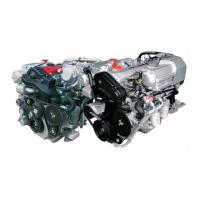Page COOLING SYSTEM - 6 Z001019/0_6_July 2008
SERVICE MANUAL MARINE ENGINES
05 COOLING SYSTEM
05.00.03 Error Detection Cooling System
1 Ask for the following information:
- How old is the device (engine number and model)?
- How many operating hours (wear and corrosion)?
- How long does the problem already exist (gradual or sudden occurence)?
- Operating conditions prior to occurence of problem (interior waters, salt water, muddy
or sandy water?)
- What repair- or service works have already been carried out (exchange of impeller, etc.)?
- At what engine speed does the problem occur?
- At what engine load does the problem occur?
2 Raw water circuit (external)
2.1 At first, take into consideration the following possibilities:
- Defective or faulty cooling water temperature sensor (high-riser)
- Sufficient rate of flow for raw water
- raw water pick-up damaged or clogged
- wrongly mounted raw water pick-up
- raw water filter clogged
- stop valve (bottom valve) defective (only opens partially)
- Raw water pump
- impeller defective (broken or strong wear)
- suction pipe from raw water filter to raw water pump clogged or deformed
- shaft bearing defective
- Sealing
- O-ring of impeller housing defective
- impeller plate seal
- Tandem cooler contaminated (e.g. through a part of broken impeller)
- Tube stake - intercooler contaminatd
- Heat exchanger exhaust
- contaminated
- seal in heat exchanger cover defective.
- Ventilation
- Alga vegetation on quill
- Deformations on hull, etc.
2.2 - Problems of raw water supply due to troubles in the drive unit
- defective seals or water pipes in lower gear box
- damaged rubber seal on water pipe
- damaged seal on box inlet
- leaky impeller plate seal
- leaky O-ring on impeller housing
- defective hose connection between pivot housing and Cardan housing
- observe notes and instructions of manufacturer.
2.3 - Inspection wether air reaches raw water.
Procedure: Replace water hose between raw water pump and tandem cooler (fuel/hydraulic
cooler) by transparent plastic hose. Let the device run in a test tank or with the boat
in water, at rotation speeds which cause an overheating, in order to detect a possible
bubble formation in the transparent plastic hose.
ToC

